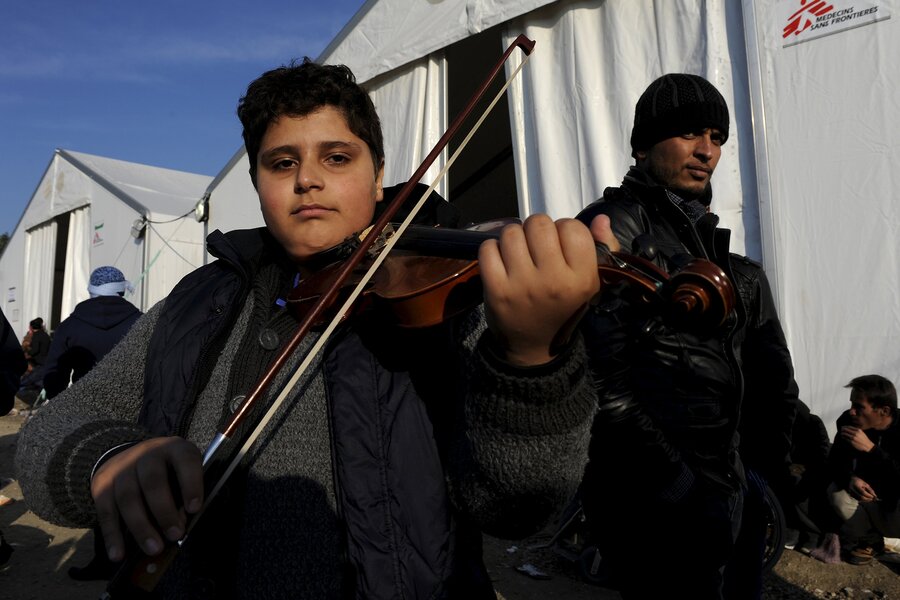'Voices of the voiceless' come to life on Holocaust victims' violins
Loading...
When 300 Auschwitz survivors gathered last January for the 70th anniversary of the liberation of the concentration camp, the annual commemoration was especially poignant: With survivors now in their 80s and 90s, many worried about how future generations would learn about the Holocaust.
"Never again" has been a vow of survivors, Holocaust scholars, and human rights advocates for decades, even as their education efforts seek new ways to educate about the Holocaust, as first-person testimonies dwindle.
For Israeli violin craftsman Amnon Weinstein, music is a way to honor the six million Jewish victims killed by the Third Reich. But it represents more than despair.
"Wherever there were violins, there was hope," says Mr. Weinstein, who has been working for 20 years to bring the lost violins of Holocaust musicians back to life, a project culminating this fall in Violins of Hope, a Cleveland-area partnership of museum exhibitions, orchestra performances, and lectures to give voice to Jewish communities who embraced music as a means of survival and resilience, even inside concentration camps.
"An instrument becomes part of the person which plays it," Cleveland Orchestra conductor Franz Welser-Möst told CBS's Serena Altschul, in an interview airing Sunday, the first night of Hanukkah. "It's the voice of that person comes through the instrument. And just knowing that some of these people who have owned these instruments did not survive, but their personality is still within these instruments, I find that very moving."
Weinstein's father, who was also a luthier, or stringed-instrument crafstman, escaped Europe for Palestine in 1938. But the remainder of his family, some 400 people, were all killed.
Decades ago, one of the younger Mr. Weinstein's clients brought in an instrument for restoration: the violin he was ordered to play at a concentration camp, the case of which still contained ashes. In 1996, Weinstein set out to collect as many Holocaust-era violins as possible, tracing their owners' stories and carefully refurbishing them to be played today.
"When I heard [Israeli virtuoso] Shlomo Mintz play the violin in Birkenau, it changed my life. It was at that place and at that moment that I heard the power of violins," he explains in a film by Blue Press. "It is the best proof that it is impossible to kill the Jewish culture and the violin which is one of the major symbols of Jewish culture."
"It was forbidden to the Jewish to pray," in the camps, he tells Ms. Altschul, so "the violin was praying for them." He repeats famous violinist Isaac Stern's quip about the violin's central role in Jewish music: "'It is the easiest instrument to pick it up and to run away!'"
In September, Mr. Mintz joined the Cleveland Orchestra for a performance of Mendelssohn's Violin Concerto, Schoenberg's Kol Nidre, and other scores, with several artists using the victims Weinstein had rescued from history. Violins of Hope has held numerous concerts, some featuring the work of Holocaust-era Jewish composers, to accompany an exhibit of 19 violins at the Maltz Museum of Jewish Heritage, closing January 3. In mid-November, the Israeli Philharmonic Orchestra, founded in 1936 as the Palestine Orchestra, traveled to Cleveland for a joint performance.
"When Amnon created the Violins of Hope, it wasn't to put them on a table and have somebody look at them," organizer Richard Bogomolny told CBS. "It was that they had to be played, because that's the only way the voices of the voiceless could be heard."
"We cannot afford to move in the direction of devaluing the life of anyone," violinist Annie Fullard told Cleveland Classical ahead of her quartet's own performance with Violins of Hope. "We know that artists can celebrate culture, and connecting with each other is how we keep our humanity."
The message of the Violins of Hope project may be particularly poignant in the wake of violence like the Paris attacks, but also has a new resonance as cultural and religious figures, including Jewish leaders, decry increasingly aggressive campaign rhetoric against American Muslims and Muslim refugees fleeing the destruction of ISIS.
A mid-November article in The Washington Post, comparing the plight of today's Syrian refugees with World War II-era Jewish ones, has launched fierce debate between those who find the analogy ahistorical, or offensive, and historians who point out that many Americans feared European refugees in the 1930s would infiltrate the country with Communist sympathizers.
In a 1939 poll asking if Americans supported bringing 10,000 Jewish children to the United States, 61 percent said no: a historical lesson that, for many, has alarming echoes of the resistance of many US governors to admitting even handfuls of Syrian refugees to their communities, citing security fears.
The Anti-Defamation League, which fights anti-Semitism, has repeatedly criticized Republican presidential contenders like Donald Trump and Ben Carson for inflammatory speech that stereotypes Muslims.
In response to Mr. Trump's apparent support for a "Muslim database," American Jewish Committe Executive Director David Harris called the idea "morally repugnant, not to mention unconstitutional," according to the Jewish Telegraphic Agency.
"What Mr. Trump proposes, in this case targeting all Muslims, is a horror movie that we Jews are quite familiar with," Mr. Harris added.
"Dear Donald Trump," liberal Jewish group Bend the Arc wrote, "When we say ‘never again’ it’s not just about Jews, it’s about everyone."








